Related Research Articles
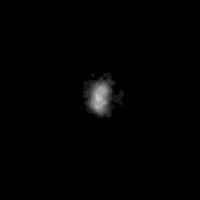
Nereid, or Neptune II, is the third-largest moon of Neptune. It has the most eccentric orbit of all known moons in the Solar System. It was the second moon of Neptune to be discovered, by Gerard Kuiper in 1949.
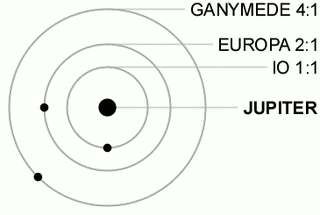
In celestial mechanics, orbital resonance occurs when orbiting bodies exert regular, periodic gravitational influence on each other, usually because their orbital periods are related by a ratio of small integers. Most commonly, this relationship is found between a pair of objects. The physical principle behind orbital resonance is similar in concept to pushing a child on a swing, whereby the orbit and the swing both have a natural frequency, and the body doing the "pushing" will act in periodic repetition to have a cumulative effect on the motion. Orbital resonances greatly enhance the mutual gravitational influence of the bodies. In most cases, this results in an unstable interaction, in which the bodies exchange momentum and shift orbits until the resonance no longer exists. Under some circumstances, a resonant system can be self-correcting and thus stable. Examples are the 1:2:4 resonance of Jupiter's moons Ganymede, Europa and Io, and the 2:3 resonance between Neptune and Pluto. Unstable resonances with Saturn's inner moons give rise to gaps in the rings of Saturn. The special case of 1:1 resonance between bodies with similar orbital radii causes large planetary system bodies to eject most other bodies sharing their orbits; this is part of the much more extensive process of clearing the neighbourhood, an effect that is used in the current definition of a planet.

Umbriel is a moon of Uranus discovered on October 24, 1851, by William Lassell. It was discovered at the same time as Ariel and named after a character in Alexander Pope's 1712 poem The Rape of the Lock. Umbriel consists mainly of ice with a substantial fraction of rock, and may be differentiated into a rocky core and an icy mantle. The surface is the darkest among Uranian moons, and appears to have been shaped primarily by impacts. However, the presence of canyons suggests early endogenic processes, and the moon may have undergone an early endogenically driven resurfacing event that obliterated its older surface.

Pluto is a dwarf planet in the Kuiper belt, a ring of bodies beyond the orbit of Neptune. It is the ninth-largest and tenth-most-massive known object to directly orbit the Sun. It is the largest known trans-Neptunian object by volume, by a small margin, but is slightly less massive than Eris. Like other Kuiper belt objects, Pluto is made primarily of ice and rock and is much smaller than the inner planets. Pluto has only one sixth the mass of Earth's moon, and one third its volume. Pluto was recognized as a planet until 2006.
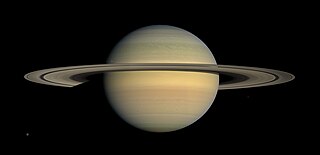
Saturn is the sixth planet from the Sun and the second-largest in the Solar System, after Jupiter. It is a gas giant with an average radius of about nine-and-a-half times that of Earth. It has only one-eighth the average density of Earth, but is over 95 times more massive.
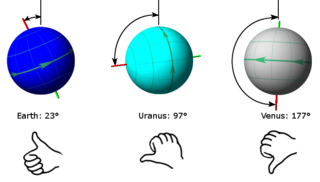
In astronomy, axial tilt, also known as obliquity, is the angle between an object's rotational axis and its orbital axis, which is the line perpendicular to its orbital plane; equivalently, it is the angle between its equatorial plane and orbital plane. It differs from orbital inclination.

Gerald Jay Sussman is the Panasonic Professor of Electrical Engineering at the Massachusetts Institute of Technology (MIT). He has been involved in artificial intelligence (AI) research at MIT since 1964. His research has centered on understanding the problem-solving strategies used by scientists and engineers, with the goals of automating parts of the process and formalizing it to provide more effective methods of science and engineering education. Sussman has also worked in computer languages, in computer architecture, and in Very Large Scale Integration (VLSI) design.

Hyperion, also known as Saturn VII, is a moon of Saturn discovered by William Cranch Bond, his son George Phillips Bond and William Lassell in 1848. It is distinguished by its irregular shape, its chaotic rotation, and its unexplained sponge-like appearance. It was the first non-round moon to be discovered.

Enceladus is the sixth-largest moon of Saturn. It is about 500 kilometers in diameter, about a tenth of that of Saturn's largest moon, Titan. It is mostly covered by fresh, clean ice, making it one of the most reflective bodies of the Solar System. Consequently, its surface temperature at noon reaches only −198 °C, far colder than a light-absorbing body would be. Despite its small size, Enceladus has a wide range of surface features, ranging from old, heavily cratered regions to young, tectonically deformed terrain.

Uranus, the seventh planet of the Solar System, has at least 27 moons, most of which are named after characters that appear in, or are mentioned in, the works of William Shakespeare and Alexander Pope. Uranus's moons are divided into three groups: thirteen inner moons, five major moons, and nine irregular moons. The inner and major moons all have prograde orbits, while orbits of the irregulars are mostly retrograde.
Comet dust refers to cosmic dust that originates from a comet. Comet dust can provide clues to comets' origin. When the Earth passes through a comet dust trail, it can produce a meteor shower.

Peter Goldreich is an American astrophysicist whose research focuses on celestial mechanics, planetary rings, helioseismology and neutron stars. He is the Lee DuBridge Professor of Astrophysics and Planetary Physics at California Institute of Technology. Since 2005 he has also been a professor at the Institute for Advanced Study in Princeton, New Jersey. Asteroid 3805 Goldreich is named after him.

The formation of the Solar System began about 4.6 billion years ago with the gravitational collapse of a small part of a giant molecular cloud. Most of the collapsing mass collected in the center, forming the Sun, while the rest flattened into a protoplanetary disk out of which the planets, moons, asteroids, and other small Solar System bodies formed.

A contact binary is a small Solar System body, such as a minor planet or comet, that is composed of two bodies that have gravitated toward each other until they touch, resulting in a bilobated, peanut-like overall shape. Contact binaries are distinct from true binary systems such as binary asteroids where both components are separated. The term is also used for stellar contact binaries.
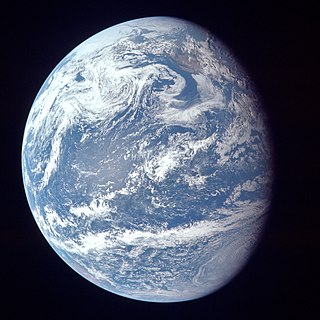
An ocean world, ocean planet, panthalassic planet, maritime world, water world or aquaplanet, is a type of planet that contains a substantial amount of water in the form of oceans, as part of its hydrosphere, either beneath the surface, as subsurface oceans, or on the surface, potentially submerging all dry land. The term ocean world is also used sometimes for astronomical bodies with an ocean composed of a different fluid or thalassogen, such as lava, ammonia or hydrocarbons. The study of extraterrestrial oceans is referred to as planetary oceanography.

The Mars trojans are a group of trojan objects that share the orbit of the planet Mars around the Sun. They can be found around the two Lagrangian points 60° ahead of and behind Mars. The origin of the Mars trojans is not well understood. One theory suggests that they were primordial objects left over from the formation of Mars that were captured in its Lagrangian points as the Solar System was forming. However, spectral studies of the Mars trojans indicate this may not be the case. Another explanation involves asteroids chaotically wandering into the Mars Lagrangian points later in the Solar System's formation. This is also questionable considering the short dynamical lifetimes of these objects. The spectra of Eureka and two other Mars trojans indicates an olivine-rich composition. Since olivine-rich objects are rare in the asteroid belt it has been suggested that some of the Mars trojans are captured debris from a large orbit-altering impact on Mars when it encountered a planetary embryo.
The stability of the Solar System is a subject of much inquiry in astronomy. Though the planets have been stable when historically observed, and will be in the short term, their weak gravitational effects on one another can add up in unpredictable ways.
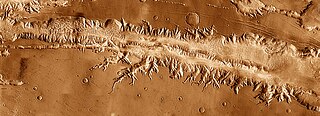
Ius Chasma is a large canyon in the Coprates quadrangle of Mars at 7° south latitude and 85.8° west longitude. It is about 938 km long and was named after a classical albedo feature name.

A planetary-mass moon is a planetary-mass object that is also a natural satellite. They are large and ellipsoidal in shape. Two moons in the Solar System are larger than the planet Mercury : Ganymede and Titan, and seven are larger and more massive than the dwarf planets Pluto and Eris.
The five-planet Nice model is a numerical model of the early Solar System that is a revised variation of the Nice model. It begins with five giant planets, the four that exist today plus an additional ice giant between Saturn and Uranus in a chain of mean-motion resonances.
References
- ↑ Jack Wisdom at the Mathematics Genealogy Project
- ↑ "Jihad Touma - the Mathematics Genealogy Project".
- ↑ Jack Wisdom (1982). "The origin of the Kirkwood gaps - A mapping for asteroidal motion near the 3/1 commensurability". Astronomical Journal . 87: 577–593. Bibcode:1982AJ.....87..577W. doi:10.1086/113132.
- ↑ Jack Wisdom (1983). "Chaotic behavior and the origin of the 3/1 Kirkwood gap". Icarus . 56 (1): 51–74. Bibcode:1983Icar...56...51W. CiteSeerX 10.1.1.394.2691 . doi:10.1016/0019-1035(83)90127-6.
- 1 2 3 4 2001 Brouwer Award Citation, AAS DDA
- ↑ Jack Wisdom; S.J. Peale; F. Mignard (1984). "The chaotic rotation of Hyperion". Icarus . 58 (2): 137–152. Bibcode:1984Icar...58..137W. CiteSeerX 10.1.1.394.2728 . doi:10.1016/0019-1035(84)90032-0.
- ↑ Gerald Sussman; Jack Wisdom (1988). "Numerical evidence that the motion of Pluto is chaotic" (PDF). Science . 241 (4864): 433–437. Bibcode:1988Sci...241..433S. doi:10.1126/science.241.4864.433. hdl: 1721.1/6038 . PMID 17792606. S2CID 1398095.
- ↑ Jihad Touma; Jack Wisdom (1993). "The Chaotic Obliquity of Mars". Science . 259 (5099): 1294–1297. Bibcode:1993Sci...259.1294T. doi:10.1126/science.259.5099.1294. PMID 17732249. S2CID 42933021.
- ↑ Gerald Sussman; Jack Wisdom (1992). "Chaotic Evolution of the Solar System". Science . 257 (5066): 56–62. Bibcode:1992Sci...257...56S. doi:10.1126/science.257.5066.56. hdl: 1721.1/5961 . PMID 17800710. S2CID 12209977. Archived from the original on September 24, 2017.
- ↑ Jacques Laskar (1989). "A numerical experiment on the chaotic behaviour of the solar system". Nature . 338 (6212): 237–8. Bibcode:1989Natur.338..237L. doi:10.1038/338237a0. S2CID 4321705.
- ↑ Jihad Touma; Jack Wisdom (1992). "Resonances in the Early Evolution of the Earth-Moon System". Astronomical Journal . 115 (4): 1653–1663. Bibcode:1998AJ....115.1653T. doi: 10.1086/300312 .
- ↑ Jack Wisdom (2006). "Dynamics of the Lunar Spin Axis". Astronomical Journal . 131 (3): 1864–1871. Bibcode:2006AJ....131.1864W. doi: 10.1086/499581 .
- ↑ Jennifer Meyer; Jack Wisdom (2007). "Tidal Heating in Enceladus". Icarus . 188 (2): 535–539. Bibcode:2007Icar..188..535M. CiteSeerX 10.1.1.142.9123 . doi:10.1016/j.icarus.2007.03.001.
- ↑ Jennifer Meyer; Jack Wisdom (2008). "Tidal Evolution of Mimas, Enceladus, and Dione". Icarus . 193 (1): 213–223. Bibcode:2008Icar..193..213M. doi:10.1016/j.icarus.2007.09.008.
- ↑ Jack Wisdom; Matthew Holman (1991). "Symplectic maps for the n-body problem". Astronomical Journal . 102: 1528–1538. Bibcode:1991AJ....102.1528W. doi:10.1086/115978.
- ↑ Wisdom, Jack (2003). "Swimming in spacetime: motion by cyclic changes in body shape". Science. 299 (5614): 1865–1869. Bibcode:2003Sci...299.1865W. doi: 10.1126/science.1081406 . PMID 12610230. S2CID 8571181.
- ↑ Andersen, P. H. (1988), "Jack Wisdom received the 1987 Warner Prize of the American Astronomical Society.", Physics Today, 41 (11): 99–104, Bibcode:1988PhT....41k.102A, doi:10.1063/1.2811630
- ↑ "AAS Fellows". AAS. Retrieved 1 October 2020.